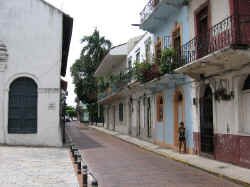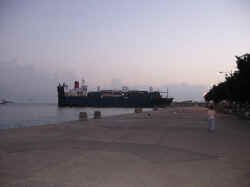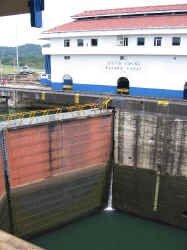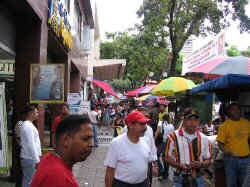July 12, 2005
This is our last day with our expedition vehicle before we ship it off to Venezuela. We have been told that although the ship only takes three days, we will be homeless for six nights. We have to bring the Fuso to the port a day early (just so it can sit in their lot), then the ship arrives on Saturday night after the government offices close for the weekend, so the earliest we can get it back will be Monday morning.
We decide to get up early to get a bit more bird watching in and to stretch out the day a bit more. We head up to the Gatun Locks on the Caribbean side of the canal to check out these mammoth creations. One thing about Panamanian roads is their almost complete lack of directional signage. After taking a wrong turn or two, and slamming into an unexpected "topé", we make it to the locks.
| The Gatun Locks raise southbound ships 25.9m from Caribbean waters to the level of Lago Gatun. From there, ships travel 37km to the Pedro Miguel Locks which lower southbound ships 9.3m to Lago Miraflores where they are then lowered back to sea level. While we watch, a huge roro ship goes through the locks and we imagine our Fuso inside of it. The ship is so huge that from a distance we mistake the high flat sides of the ship for a building at the locks. |
|
We have been told that our truck must be "as clean as new" otherwise we might run into problems at the port. We presume this is due to fears that the dirt on the body could contain germs or diseases that Venezuela doesn't want to have us unintentionally bring into the country. Luckily we find a car wash in a gas station and persuaded them to hand wash our "little" baby.
The port city of Colon actually has two ports and of course we go first to the wrong one. We find that our port, Manzanillo, is located on the other side of town and across the bay. Arriving at the port, we can see lines of heavy trucks, some waiting to load containers into the port, and others waiting to clear customs to bring the containers into the country. We find a spot to park and then start the process of checking the Fuso into the port.
We head over to the offices of our shipping agent, Barwil Inc. and one of their representatives decides to walk with us to handle the paperwork for us. It takes about one hour to get the proper stamps, then we have to prepare our personal belongings in our backpacks to become backpackers again. We take some photos of the truck entering the port, say goodbye, and hail a taxi into town to catch the Panama Canal Railway train back to the Pacific side of the country and Panama City.
The train ride was very enjoyable. The scenery was terrific as it passed through jungle and across Lago Gatun. Another enjoyable aspect of the ride was the people watching. There were people of every shape, size, color, religion etc. and it was very interesting to see how the building of the canal brought together people from all over the world.
Arriving back in Panama City, we were surprised to find that our taxi ride would take us back past the Policia Technica Judicial where we spent half the day on Monday getting our export documents. As we drive by, we notice groups of people standing around, some appear to be hiding behind the supports of the bridge that goes overhead. As we watch and try to figure out what is happening, we hear guns firing and people running. Somehow we have driven right by a gun battle! We encourage our taxi driver to step on the gas and get us out of there! We can't imagine what just happened, but we see other drivers doing what they can to get away as well.
We checked into a hostel full of young backpackers to spend the next couple of nights while we explore Panama City and arrange for our flight to Venezuela.
July 13, 2005
We spent this morning running some errands to the shipping agent to get our bill of lading for the vehicle and purchasing plane tickets to Caracas. We spent the afternoon exploring Casco Viejo, which is the old part of Panama City. With its mix of colonial architecture, cobblestone streets and ethnic diversity, it is one of the more interesting parts of Panama City. The area is slowly being restored and a handful of artists have settled in the area. It is quite a mix of fixed up and dilapidated. This area also contains the presidential palace which is a beautiful 350 year old building called the Palace of Herons. But it was very surprising to see roof-less and wall-less buildings just a few steps away. We had dinner at a great Lebanese restaurant and again really enjoyed the diversity of the people who have come to live and work in the canal zone.

July 14, 2005
We caught our plane this morning to Caracas and landed mid-afternoon. We had thought about immediately heading off to another city that we wouldn’t be driving to, but we were thwarted at every turn when flights turned up full for the next couple of days. OK, so we’ll just spend some extra time in Caracas. We caught a shuttle from the airport into downtown, and then took a metro train (subway) to the Altamira section of town. It was right in the middle of rush hour so we got to experience the crush of people as they took the train home. We were lucky to get a seat as we were traveling completely across the city. The stations and the trains were packed with humanity, it was hard to see how everyone was able to move about, yet there was courtesy as people did move a little to let others off the trains before they pushed their way on.
Our Lonely Planet guidebook listed 5 hotels in ascending order of price and the first one we came to was a little pricier than we had hoped. Deciding to look further, we checked out the least expensive option. Full. OK, we continued on to the next one and it too was full. Uh, oh. Heading back to the first hotel, we received the discouraging news that they too, were now full. (Why didn’t they tell us it was the last room?) OK, now our last two options are the most expensive hotels in that section of town. But what else are you going to do? Both full. What is going on? We never got an answer to why every hotel was full, but after returning a second time to the second most expensive hotel, they found a room for us.
July 15
Spent this morning hoping to get our Brazil visas, but alas after running around getting photos, checking to make sure we could get cash from the ATM machines and finding the Brazilian embassy, the consul informed us that it would take 5 days for them to process our visa applications. OK, we’ll take care of that in another city, it turns out that Brazil has consulates in two other Venezuelan cities that we will be traveling through.
In front of a subway entranced we noticed a large group of people blocking the roadway. All the people had white lab coats on and they were carrying signs protesting what we thought was low salary in the medical profession. They were very orderly, and the people stuck in their cars going nowhere seemed to be unusually patient. We guessed that protests must be a way of life in the city and everyone just takes it in stride. We then took the subway to the old central part of Caracas and between rain storms tried to visit all of the Simon Bolivar museums and monuments that we could. Unfortunately, because we were wearing shorts, we were not allowed in some of them. They thought it was disrespectful. Yet you should see what the women wear, or rather what they have showing!
|
|
We finally ran out of time before we could visit his mausoleum and ran back through another rainstorm to jump on the metro. Along the way, several people stopped us to make comments about being careful in the city as safety has become an issue for people walking on the streets. Mostly the problems seem to happen at night in the less active parts of town. Our policy has always been "don’t do anything you wouldn’t do at home". So we don’t take unnecessary risks by walking at night, going down alleys, or wandering where nobody else is around. |
July 16, 2005
We’ve been without our Fuso for four nights now and are getting a bit tired of sleeping in hotels and eating in restaurants. The ship that is to bring our vehicle from Panama is scheduled to arrive late tonight at the port city of Puerto Cabello, about 3 – 4 hours west of Caracas, so we’ve decided to go there to wait for it. Unfortunately, since the boat will be arriving on Saturday night, we will have to wait until the government offices open on Monday to compete the paperwork to be able to drive it in Venezuela.
Thinking that it would be nice to visit a smaller city for a couple of days, we decided to take a bus to Puerto Cabello. Well it seems that many of the Caraquenos (residents of Caracas) head out of town on weekends, and when we arrived at the bus station, we found we had a 4 hour wait, as all the earlier direct buses were sold out.
Not wanting to wait around, we decided that it couldn't be that much more difficult to take a bus part way, then transfer to another bus. So we had an interesting day, took three buses including a slow local bus that stopped for anyone, and it seemed everyone, arriving at our destination at about the same time as if we had just waited for the more direct bus. But then we wouldn’t have had the opportunity to explore a couple of bus stations and to travel together with the average Venezuelan.
After our problem with securing a room in Caracas, we decided to buy a phone card and call ahead to the Posada (a small bed & breakfast hotel) and reserve a room. Our Posada was in a 250 year old building that had been renovated into a small hotel, and was located in the heart of the old colonial town just a block off the Malecon, or oceanfront walking area.
The Malecon ended right at the entrance of the channel where all the big container and Roro ships enter to get into the harbor. This is also where the Captain of the Port has his office, so we stopped in and asked if they had any information on our ship, the Roxanne. Yes, he said that the ship was scheduled to arrive about 6 am Sunday morning, and if we wanted to come down to the Malecon we could watch it sail by. Great.
As the sun set, vendors pushing carts, or arriving by vehicle began setting up temporary stalls along the Malecon to sell to the locals and visitors later in the evening. There were people selling food, popcorn and ice cream, as well as others selling just about anything else: bootleg dvds and cds, clothing, balloons and temporary tattoos. There were even people who set up tables to allow other people to make telephone calls using their cell phones! To light us their booths and displays, they would run wires and extension cords across the walkway where they would "hotwire" their cords right into the city power being supplied to the street lights! It was amazing to see the "rats nests" of wires and even more surprising to see that this was perfectly acceptable.
July 17, 2005
Shutting off our alarm, we dragged ourselves out of bed early to go watch for our ship. We were excited to watch our ship come in. Arriving at the channel entrance, we were in time to watch several container ships and a Roro enter the harbor, but none were our ship. After nearly two hours, we gave up and went back to our room.

We had been told by our agent in Panama City that it was possible that the ship could be delayed by a day, so we tried not to be too concerned. But now we were excited about watching the ship arrive and wanted to be on the Malecon when it went by. We decided to spend the day just kind of hanging out, watching. As the day went by, Kim went back to the Captain of the Port to ask if they had any updated info, and was told that they didn’t know when it would arrive. Bummer!
But wait, a couple of hours later we went back down along the Malecon, which was even more crowded with people then the night before – and there was our ship coming into the channel! Now we’re excited, we can get our Fuso back and we can get back on the road so we can explore this big country.
July 18, 2005
First thing this morning we arrived at the offices of Paragua, our shipping agents for Venezuela. They were very helpful and assigned us an English-speaking interpreter to help us through the labyrinth of governmental paperwork required to retrieve our truck. We took a taxi to the Aduanas (customs building) and attempted to start the process. But wait, first we needed to return to our hotel to change our clothes, as we weren't allowed in the customs building in shorts (aargh). Once we returned, we moved from office to office, showing our bill of lading, our title, our passports and anything else anybody wanted to see. Julio, our interpreter, calmly and patiently explained our situation. We figured out that it isn't very common for individuals to ship vehicles, so everyone was learning as they went. By noon, we had done all we could do and were told to return in the afternoon to retrieve our paperwork. Relaxing for the first time today, we stopped in a restaurant for lunch and had a wonderful, typical Venezuelan comida criollo, meal of the day, in this case, carne asada and chicken with rice, vegetables, potatoes and arepas (corn cakes).
Heading back to the Aduana, alone, in the afternoon, we tracked our paperwork down and were asked to wait while a signature was obtained from the boss. While we were waiting we did some great people watching. Just about everyone in the building was associated in some way with the shipping business and the sense of energy and urgency was palpable. After waiting for over an hour, it was getting close to 5:00 and we knew everyone would start going home. We tracked down one of the agents who had been helping us and asked about our paperwork. He looked very surprised to see that we were still waiting and hurried to get the necessary signature. After a couple of more minutes, paperwork in hand, we exited the building.
Next stop was the customs house that was storing the Fuso. But wait, it is now after 5:00 and the office that needs to give us the visitors pass to get into the port is closed, so we'll have to return in the morning. This will now be our seventh night without the Fuso (for a three day shipment).
July 19, 2005
Again, first thing in the morning we are back at the port. We got our visitors pass and headed to Intermarca, the customs house. The port is huge and they have a bus that moves people around. After waiting for a while the bus finally drops us at the office, only to find that the Fuso is being stored in a different area. Back to wait again for the bus. Finally we arrive at the correct spot, and there it is, across the parking lot, our beloved Fuso. So close and yet so far away. Showing our paperwork to the warehouse people, we are excited because we can now make our inspection of the vehicle. Slowly walking around it, we find everything to be in excellent order. It is a little dirtier than when we left it, but everything is intact and we are thrilled. Can we go now? No. Turns out that we need a letter from Paragua, our customs broker, releasing the vehicle. It's a good thing taxis are cheap because we sure have been running back and forth a lot. So it's back to Paragua where we get our letter and again Julio accompanies us back to the Intermarca office. Thank goodness we have lots of copies of everything because everybody wants one. Finally, yes, you can have your vehicle and you're done. But not really. As soon as we try to drive out of Intermarca, the guard at the gate tells us there is another bit of paperwork to be done. Back out of the vehicle and into the building. Five minutes later, we are out the gate and heading to the port exit. Oops, wrong exit, need to go to a different one. More people who want copies of our paperwork, almost, almost, FREE! Halleluiah!
After leaving Puerto Cabello, we headed off for Parque Nacional Henri Pittier for our first night back in the Fuso. But first we had to stop for gas. We had heard that Venezuela has some of the cheapest gas in the world and we weren't disappointed. The price of regular unleaded gas is $.15/gallon. The price of diesel, which we use, is $.08/gallon. Yes, 8 cents. It cost us about $2.00 to fill the tank. We still had some food as our wonderful Tundra refrigerator had kept some things frozen during the entire shipping process, so we didn't have to do any shopping right away. It was a good thing too, because it took some effort to find the correct road. But the drive up through the cloud forest was beautiful. We had to dodge quite a few low hanging trees and on a narrow winding road we were sometimes on the wrong side on a blind curve. Fortunately, there was very little traffic. Arriving at the Estacion Biologica Rancho Grande, we found the gate closed, so we parked on the side of the road for the night. There was more traffic than we would have expected, but nobody bothered us.
July 20, 2005
This morning we hiked around the Biological Station hunting for birds. This park is famous for its birds. About 580 species have been identified, that represents 43% of the bird species found in Venezuela and 7% of all the birds known in the world. We didn't see that many, but we did see a Yellow-billed Toucanet, a Green Oropendola, a possible Painted Parakeet, a possible Ruddy Spinetail, several hummingbirds, a woodpecker and various other birds that we couldn't identify. The administration building is a spooky building. First thing, it is huge, the next is that it is unfinished with walls and flooring missing. Turns out that the building was started as a palace for the dictator Juan Vicente Gomez in the 1930's and when he died, the workers left and the building was never finished. It was a beautiful area with waterfalls and a view back down to the valley and Lago Valencia.
Leaving the park, we enjoyed the drive back down through the cloud forest and entered the real world again of traffic. It took the entire afternoon to drive 110 miles, what with traffic, landslides, construction and maniac drivers and we were really glad to make across Caracas in one piece. It is common practice for drivers to ignore the lines on the roadway, drive on the shoulder and to treat stop lights as yield signs. We spent the night in the parking lot of a hotel in Guatire.

